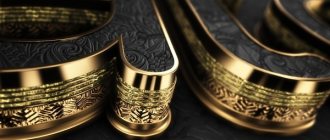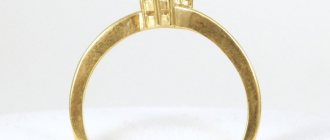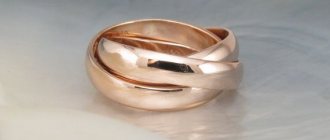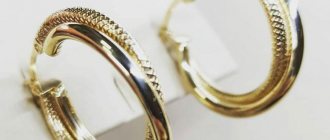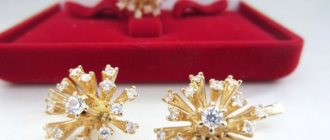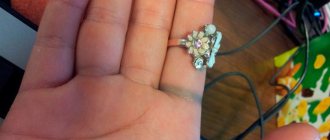Go to the online store
13.072020
Wedding rings made of red gold differ from their counterparts made of yellow or white metal in a brighter and catchier look. Many newlyweds who pay attention to products with a red tint are interested in how this type of gold differs from others, and why jewelry made from it is becoming more and more popular. You can find answers to these and other questions below.
What is red gold?
Gold gets its red color from copper. Adding it to the alloy makes the precious metal more durable, because jewelry made from pure gold is usually fragile and easily deformed. The more copper there is in the metal, the stronger and more saturated the red tint. Also, up to 10% palladium can be added to the alloy, which gives gold a deep brown-red hue. Adding some silver, on the contrary, will soften the color. The sample depends on the percentage of alloy in the alloy composition. For example, if 100 g of alloy contains 58.5 mg. pure metal, then the product will have a 585 standard.
Rings made of 585 red gold can be worn every day, because... they withstand the negative effects of the environment well. Even a simple decoration made from it looks very impressive. The value of such gold for jewelry makers lies in its durability and strength. Such qualities allow you to create fairly light jewelry from red metal without fear that it will lose its shape.
What is red gold
This is not a pure metal (gold without impurities, 999 fine - yellow, without redness), but an alloy of gold and copper.
It is copper that gives it its exquisite reddish tint. The technical term “red gold” has long been outdated and is used only colloquially. Such an alloy is now very rare and is practically not used, since it is very impractical and inconvenient for everyday use. Jewelry made from such gold can only be obtained by individual order from a jeweler or antique dealer.
Application
By adding alloying metals you can not only change the color of gold, but also improve its durability. Since the red material itself is quite fragile, and therefore is practically not used in jewelry.
Most often, such gold-containing material is used to make investment bars, as well as bank coins.
The noble material of high standard is resistant to corrosion, which is why it is used in the electrical industry. It is used to treat contacts in order to protect them from oxidation. In this case, the current conductivity does not decrease.
Scarlet gold is also widely used in the chemical industry, as it is an excellent catalyst.
History of origin
Chervonny (scarlet), translated from Old Church Slavonic, means red, scarlet. In Tsarist Russia, chervonets were originally the name given to foreign gold coins - ducats, sequins, florins. Own coins have been minted in Rus' since the 15th century as award insignia.
The first Russian chervonets as a means of payment appeared as a result of the monetary reform carried out by Peter the Great. In terms of weight and alloy value, they corresponded to foreign coins and were intended only for settlements with foreign subjects.
A common practice was to make expensive jewelry from chervonets, because purer gold simply did not exist at that time due to the impossibility of higher purification. Therefore, red gold is still mistakenly considered to be the name of a chemically pure element.
The history of the appearance of red gold. Why is it still considered the purest?
Many people still use the term red or scarlet gold, meaning native metal, due to ignorance considering it red. What is red gold really? Scarlet metal is an alloy consisting of 900 grams of pure noble metal and 100 grams of alloy per 1000 weight units.
Red gold is a metal known since ancient times, as evidenced by products that have survived to this day and are of historical value.
When a large amount of copper was added to the alloy, the metal acquired a rich red tone when heated, which is why in Russian times it was nicknamed red. Other metals do not display this color when heated, but rather become pale and sometimes darken.
Mining pure gold
Some of the yellow metal is mined in the form of nuggets or sand, that is, initially in a metallic state. The degree of purity of the precious metal largely depends on the characteristics of the deposit itself where mining is carried out. The sample can vary over a very wide range; its further increase to the required parameters can only be achieved by subsequent purification.
Gold mining by dredge.
Industrial metal mining is carried out using large dredges through which the rock is washed. Among the chemical methods for obtaining gold, there are three:
- Amalgamation;
- Cyanidation;
- Refining.
Amalgamation is one of the oldest methods of isolating gold. The crushed rock is mixed with mercury, which then envelops the precious metal. After this procedure, all that remains is to separate the mercury from the rock, and then the gold from the mercury. This method is now practically not used, since it can only be used on rich rocks.
Most often, cyanidation is used to obtain pure gold. This method is implemented at large enterprises in the mining industry. Gold is dissolved in hydrocyanic acid salts, and then isolated from the resulting solution.
Installation for cyanidation.
Refining is used to separate precious metals from polymetallic ores and process secondary raw materials. First, the source material is crushed, fired and alloyed with zinc, then sulfuric and nitric acids are included in the process, after which the final release of the yellow metal follows.
Depending on the method of obtaining the precious metal, its purity will vary. When producing gold using mercury, the sample of the element depends entirely on the characteristics of the deposit. The metal is released along with impurities, so it is then necessary to either send it for refining or use it where the resulting sample of gold is sufficient. It is almost impossible to obtain pure material using this extraction method.
Gold refining at the Novosibirsk plant.
Refining technologies allow you to set the metal sample. Theoretically, using this method it is possible to obtain a final alloy with any precious metal content. The highest 999 standard is also obtained by this method.
The benefit from using the above methods largely depends on how much one gram of the resulting red gold costs on the precious metals market.
How can you tell if a piece of jewelry is made of red alloy?
When choosing jewelry made from a precious alloy, you need to pay attention not only to the purity of the gold, but also to the weight of the jewelry. Since pure material is quite soft, jewelers increase its strength by adding other metals. Therefore, for example, a woman’s ring cannot weigh less than 7 g. And if a store offers openwork jewelry, it cannot be made of high-grade red material.
The higher the sample of the material, the softer it is. Therefore, you can check the jewelry “by the tooth.” If after a bite there are teeth marks left on the product, then the purity of the alloy is high.
You can try heating the decoration. If it changes color to red, it means its copper content is high. If the shade is slightly perceptible, the sample of the product is high.
Gold has become the equivalent of the global financial system. Most states accumulate precious metal in case of collapse of the monetary system. Exchanges around the world daily monitor the price of gold, and we are talking about the noble metal of 999 purity, that is, pure, red gold.
Therefore, we can conclude that red gold is still the main equivalent for measuring money today.
How it is made
Red gold is obtained by introducing a certain amount of copper into the composition. Such additions to precious metals are called alloys.
Nowadays, an alloy of a similar shade is also used, but its standard is much lower, and in addition to copper, it contains silver. This three-component alloy is widely used today due to its good strength and malleability. It lends itself well to soldering. Products made from this alloy are more durable, and the visual difference between the two types of gold is a slight difference in shades of red and is noticeable only upon close inspection.
Next, watch an interesting video about how gold is made:
Alloying metals
When making an alloy, various metals are added to gold, which are called alloys. This is done in order to give the noble alloy the necessary qualities:
- A shade of red indicates the presence of copper impurities in the alloy. If the color is saturated, it is not red, since the amount of ligature in it exceeds the permissible value (less than 10%). Copper gives gold strength without changing its elastic properties. But wear resistance and corrosion resistance are reduced;
- By adding silver, you can increase the hardness of the alloy while maintaining its ductility and malleability. In addition, it lowers the melting temperature of this noble metal. Silver gives it a green or white tint;
- platinum changes the color of gold even at a small content. For example, adding only 8% metal to an alloy makes it white. Platinum increases the melting point significantly;
- Thanks to the addition of nickel, the strength and ductility of the precious metal can be increased. The color becomes pale yellow;
- You can change the color of gold from yellow to white using palladium. To do this, 10% metal impurity can be added to the alloy. This does not change the malleability of the alloy;
- the addition of zinc reduces the melting point and hardness of the alloy;
- cadmium acts on the precious alloy in a similar way, but its elasticity is retained when added.
The influence of impurities on the color of gold
Everyone knows that pure gold is yellow. But, depending on the presence of impurities in its composition, it may change its shade.
How to use a ligature for gold:
- copper;
- silver;
- palladium;
- zinc;
- aluminum;
- nickel;
- cadmium;
- platinum
Copper, when heated, gives the noble yellow metal an aristocratic reddish tint. Moreover, the more copper in the alloy, the brighter this shade will be visible. But such alloys have one very significant drawback - unlike pure gold, such an alloy will already be susceptible to corrosion.
Aluminum, unlike copper, does not reduce corrosion resistance, but it also imparts hardness to the alloy.
Silver gives the yellow metal a greenish or whitish tint. Alloys of gold and silver are much stronger than pure gold products.
Platinum and palladium impurities also change the color of the gold metal from yellow to white. Platinum is especially “ferocious” in this - 8.5% of this alloy in the alloy makes its color white. Palladium acts a little softer - you need 10% of this additive for the color to change to white.
"Russian" gold and its purity
All shades of precious metal are popular in the world: from white to black. But red gold is unofficially called “Russian”. In Russia (at least for now), multi-colored jewelry made from this precious metal is not very popular. Only recently have people become interested in the white option, but before that they preferred the traditional reddish or yellow color.
Since it is a soft metal, additives (iridium, platinum, silver, cadmium, zinc, copper, etc.) are usually mixed into it. Various impurities are called alloys. They enhance the properties of gold, most importantly, increase its strength. Additives can also change the color of the base material. The idea of dying precious metals in different shades - pink, green, white - is very old.
There is an assumption that in order to obtain a reddish nuance, in the old days a dye prepared from an extract of special worms was added to gold, hence the name “red”. Another version of the origin of the term: the obsolete word “scarlet” is “dark red”. Third option: “red” means “hot.” The fact is that when the high-grade alloy was heated, a red, that is, “red” glow appeared. If there were a lot of impurities, the color did not appear.
To increase the strength of the product, copper began to be added to gold. Its content in the alloy was minimal - 1:9, which corresponds to a modern sample of 900.
Properties of gold
Pure gold is a very soft metal. On a 10-point hardness scale (Mohs scale), in which a diamond is given 10 points, gold received only 3 points.
If a .999 engagement ring accidentally falls off your finger and hits a hard floor, it will become very deformed, almost flattened, and it will no longer be possible to put it back on your finger.
Therefore, gold in its pure form is almost never used for jewelry. But, on the other hand, pure gold is a very dense metal, second only to platinum group metals in this indicator, it conducts electricity well and is practically not subject to corrosion.
This property is widely used in electronics, covering the surface of contacts with it to protect against corrosion. It has also found its application as a finishing material - it is used to cover the domes of large church churches.
The melting point of pure gold is 1063 °C. But with the help of a ligature it can be either lowered or increased. Reduce the melting point of silver, zinc, cadmium. Platinum and palladium increase.
A large assortment of products from the salons of the Golden Gross Center
The Golden Gross Jewelry Center has 100 showrooms located on 3 floors, presenting products from more than 750 manufacturers. Among them there are jewelry from both domestic and foreign brands. In store windows you will find many original red gold rings, the design of which was developed taking into account the latest fashion trends. We work only with reliable partners who have been on the market for several years. Thanks to this, we provide customers with our own guarantee for each piece of jewelry purchased in Golden Gross stores.
It is worth highlighting the high quality of service offered by UC stores. Polite and helpful staff are always ready to help you if you have any difficulties choosing jewelry. They will tell you about the features of each product that interests you and select several optimal models. All you have to do is compare them with each other. Any jewelry presented in the showrooms can be tried on.
The stores of the Golden Gross shopping center attract the attention of customers not only with a large assortment of products and high quality service, but also with frequent promotions. Today the discount on certain categories of jewelry reaches 40-50%! And that’s not all, because almost each of our partners has their own loyalty program. By becoming a member, you will have the opportunity to save on every purchase.
Pros and cons of red gold
Only high-grade alloys have the advantages of sufficient strength; in other cases, excessive fragility and softness are observed. The surface of products made from this metal is characterized by low resistance to damage - the slightest scratches will soon become visible.
Products made from red gold often break, despite the fact that repairing jewelry is expensive. At the same time, there is absolute resistance to metal corrosion.
It is not recommended to try to rub out scratches on the product, as the entire top layer will almost certainly be erased.
Previously made items made of red gold have historical value, and banknotes have numismatic value. Therefore, they can be sold at a high price or bought at a profit as a long-term investment - the older the item, the higher its value.
Proper care of red products
Like any precious metal, scarlet metal requires special care:
- It is important to store such products separately, in a box or box with soft sides;
- Even increased resistance to corrosion does not make it protected. It is best to limit contact with liquids and chemicals;
- Jewelry made from this metal is fragile and easily deformed, which means you shouldn’t wear it every day.
Gold looks flawless if it is cleaned regularly and correctly. To do this, it is best to seek help from the experts. But at home, you can also carry out preventive cleansing. To do this, you can use a soap solution or a weak salt solution.
Jewelry
Where is pure gold used?
Precious metal has always been of great importance in the history of mankind, touching the cultural, financial and industrial spheres of society. In the financial sector, the precious metal has long been used as a standard of value: gold bars and investment coins are made from gold, the metal is actively traded on the stock exchange, many countries prefer to store their funds in gold, and the value of currencies and their exchange rates are constantly measured against its quotes.
Red gold is widely used in industry; the metal plays a special role in the electronics and electrical engineering industries. The precious metal is used to gild contacts to prevent their oxidation and increase resistance - such parts are found in any mobile phone, tablet, or laptop. Gold is in every car: in addition to electronic devices, it is present in catalytic converters.
High-grade gold is also widely used in the jewelry industry. The combination of metal and precious stones allows craftsmen to create incredibly beautiful jewelry. Adding additional components to the alloy ligature provides unusual shades of the metal, which helps expand the jewelry collections of world manufacturers.
In Soviet times, the standard of quality was considered to be red gold - 585 fineness of the metal. It is with this sample that the concept of “red metal” is often confused. Red gold is an average 585 precious metal in content, and red gold has the highest standard.
Foreign jewelers are not very fond of red gold. The reason here is not only the average sample. Many craftsmen believe that a precious metal with such a shade is not suitable as a setting for precious stones. In recent years, red metal has been more often used to make jewelry of unusual designs that exclude the insertion of stones.
Due to its low price, red gold has become popular in our country since Soviet times. The advantage of this metal sample also includes the physical qualities of the jewelry: items made from the red alloy are strong enough to withstand daily wear. Pure metal is more valuable in the banking sector, the price of red gold is the exchange price, used as a standard of value and an object for investing funds.
Types of red gold wedding rings
Wedding rings are usually created in pairs. Men's models have a more strict design, while women's models are often complemented by intricate inserts. Manufacturers offer a choice of both classic and more complex design jewelry. The variety available today allows us to satisfy the needs and wishes of all customers. The most common options:
- Classic, with a smooth flat surface. This form is universal and suits everyone. The ring is comfortable to wear, does not interfere with work and does not cling to clothing. Choosing a product of the appropriate width will help achieve the best effect.
- With stone insert. Products with red stones, such as garnet, look especially good. The diamond also takes its rightful place.
- With a pattern or engraving. This ring has an attractive appearance, which makes it stand out from many ordinary rings. This is a good choice for those who decide to abandon the ordinary and stick to their own style.
About the sample of red gold
Almost all Russian jewelers add copper to the precious alloy, and for high-quality jewelry the percentage of other metals in the alloy is strictly limited. For a red precious metal to actually be such, the content of secondary elements should not exceed 10%. You can distinguish red gold from low-grade gold even from a photo. This alloy has a reddish tint; if you see a bright red decoration, you have a lower standard with a higher copper content.
The marking of a product made of red metal cannot be less than 916 standard. In its pure form, yellow metal is very soft; small jewelry of 999 standard will be greatly deformed even with the slightest mechanical impact. To eliminate this problem, jewelers increase the mass of the material and the finished product itself. A typical red gold engagement ring can weigh 8 grams or more.
How much does this red gold cost? The price of the highest grade precious metal is quite high and now amounts to about 2 thousand rubles, which is why jewelry is made from alloys of lower grades. This metal is easier to process, more resistant to environmental influences and costs less.
Due to the high cost of pure metal, some manufacturers try to counterfeit it by adding more copper to the alloy. It is very easy to distinguish a fake from a 999 standard: when heated, the alloy with copper will become pale and cloudy.
Red gold is used to produce alloys of unusual shades. The price for one gram of jewelry made of white, pink or purple metal will depend on the content of additional components and the complexity of the process.
How to decipher a gold standard
If we are talking about the metric system, then the mark on the precious metal displays how many grams of pure substance are in a kilogram of the alloy. So, 585 standard means that 1 kg of alloy contains 585 g, or 58.5% gold.
In the karat assay system, a chemically pure substance has a hallmark of 24 carats. A hallmark of 22 carats corresponds to 916 metric hallmarks, 14 to 585.
In the spool system, the unit of calculation is taken to be a pound, equal to 96 spools.
Conversion tables are used to convert sample values from one system to another.
How does red gold differ from modern red gold?
The name of the alloy is associated with the presence of a faint reddish tone, due to the significant proportion of copper: when heated, the product acquires a bright red color. In this way, it was previously possible to determine the authenticity of coins.
When heated to a certain temperature of 750, 585 (583) samples, even a non-ferrous alloy with a high copper content does not turn red, but rather turns pale. This means that the modern red precious metal is the 583-585 standard familiar to Soviet people, which has a reddish tint, which is why it is popularly called red gold. The difference is in the percentage of base metal. But it has nothing to do with the red precious metal.
Minting coins from scarlet gold
The minting of red gold coins was carried out according to the general principle of issuing similar banknotes - on special machines. The main overlay was a blank with an imprint of applied images and symbols, but they were all arranged in the reverse order.
The device forcefully embosses a given pattern and other parameters on the material, forming a complex relief.
In total, there are two minting methods: a minimum of technology, but more manual labor and vice versa. The first case is often used for the release of limited, anniversary batches. The second is a great way to “multiply” money in millions of copies.
Among other distinctive features, during production they form a edging with a small protrusion above the main part, and also make numerous marks on the sides. This approach significantly reduces the number of high-quality fakes.
Red gold is not 999 fine
Gold mined from mines is not a perfectly pure metal and already contains a number of impurities. However, after purification, the red metal turns into precious 999 fine bullion bars and is sent for storage in banks. A bar of pure gold can be damaged, scratched, or bent without much effort. At the same time, many people mistakenly call 999 purity pure gold, meaning in this term a perfectly purified precious metal. In fact, red gold is an alloy with a high content of yellow metal and special alloy additives.
So what exactly is red gold? What is his sample? Based on its name, red gold, translated from English, means pure gold. That is, the precious metal must be without any additives at all. However, in reality it is just high-grade gold with a specific hue, which was characteristic of most high-grade precious alloys in past centuries.
How did the sample of red gold change? Why is it not applicable in jewelry now?
The sample of red gold was constantly subject to changes, but the content of pure noble metal in relation to the alloy was always at least 90%.
- During the Peter the Great era, coins corresponded to 986 fineness.
- During the reign of Catherine, it was decided to use the 916 sample.
- Nikolaev imperials were produced from 900-karat alloy.
- Chervonets of the USSR, which were issued in the years 22-25 of the 20th century, were branded with the number 900.
Currently, pure scarlet precious metal is not used for coin production or jewelry purposes. This is due to the natural softness and excessive ductility of high-grade metal. Thanks to the development of various alloys, a large number of samples with different characteristics have been replaced. If red gold existed today, then it would correspond to the highest standards.
Gold 900 standard
The most popular today is 585 standard, corresponding to 14 carats, according to the carat system or 56 spools according to the old spool system introduced by Peter I. When the evaluation system was changed, the price of products began to be determined not in carats or spools, but based on the cost of a gram of pure precious metal . Today, the price is influenced by the price of 999 fine, set by the Central Bank of Russia and the world market.
How did red gold appear?
As already mentioned, pure yellow metal of the highest 999 purity is absolutely unsuitable for use as a jewelry material. Only bank bars can be cast from pure gold, and even then care must be taken so that they are not accidentally dropped or scratched. Therefore, in past centuries, the term “pure gold” meant an alloy with a high content of pure gold, which, by today’s standards, meets a minimum of 750 fineness.
Copper was most often used as a ligature in the old days. It was thanks to copper that the precious metal acquired a dark red rich hue. It was from such an alloy based on gold with the addition of copper that coins were once minted in Rus' at the royal court. However, red gold was rarely used in the jewelry industry because it was soft and difficult to work due to its ductility. This term first appeared during the times of Tsarist Russia, however, it is sometimes used today if they want to emphasize the high standard of gold.
Category: question-answer
Is it possible to buy a red coin today as an investment?
Expert opinion
Anton Egorov
Financial Consultant
Coins made of scarlet alloy, left over from past centuries, are now quite valuable, and gradually their value is only increasing. Therefore, various products made from this type of metal can easily be purchased as a means of investment, adding to your home jewelry collection.
Our family has kept our great-grandmother’s ring for several generations since the revolution. How to find out if it is made of red gold?
Expert opinion
Grishanov Mikhail Petrovich
Jeweler, director of the Grishanov and Co. workshop
Jewelry made from scarlet precious metal is very rare; it was used mainly for issuing coins. But some family items were passed down from generation to generation and could survive to this day. Externally, red gold has a yellow color with a slight, barely noticeable reddish tint. To determine the authenticity of a scarlet alloy, you can contact a specialist. Previously, authenticity was checked by heating the product to a certain temperature. At the same time, the heated metal had a bright red hue.
Where can you see the royal red gold?
Expert opinion
Pribrezhny Gennady Valentinovich
Jeweler 6th category
Nowadays, authentic scarlet coins issued during the tsarist reign are in private collections. Occasionally, expensive specimens can be seen at museum exhibitions and auctions.
Golden coins
What does red gold look like?
Expert opinion
Grishanov Mikhail Petrovich
Jeweler, director of the Grishanov and Co. workshop
Externally, the scarlet alloy is most similar in color to gold bars, but differs in a faint red tint. It is impossible to find any more significant external differences. It is worth noting that the products are extremely soft, which is why they quickly and easily deform.
What standard is red gold?
Expert opinion
Pribrezhny Gennady Valentinovich
Jeweler 6th category
For a long time, scarlet gold of various samples was used, but the proportion of pure gold in the alloy never fell below 90%.
Color
From the Old Slavic language the adjective chervonny is translated as red. This explains the origin of the term “red gold”. On the other hand, the adjective chervonny (chervilny) comes from the words “worm” and “worm”, which means a red tint or simply to paint. In turn, the root of these words comes from the name of a certain kind of worm, from which red dye was prepared in ancient times. After many centuries had passed, the term “chervonets” began to be applied to the royal coins of the Russian Empire, and then to the chervonets of the USSR.
Spool test and gold chervonets
It is also known that in ancient times the concept of fineness did not exist, and the content of pure gold in the alloy was determined in the so-called “spools”. Thus, any gold that had at least 72 spools was considered pure gold, which today roughly corresponds to 750 fineness. It is also known that the most popular alloys of ancient times were considered precious alloys that contained 86, 88, 92 and 94 spools. If necessary, you can find information on the Internet on how to correctly convert modern gold samples into spool samples and vice versa.
Now let’s say a few more words about the minting of red gold coins. What is important here is the historical period in which these or those “chervonets” were made. For example, during the reign of Tsar Nicholas II, the mint minted gold coins exclusively of 900 fineness, which corresponds to 86.4 spools. In more ancient times, when Russia was ruled by Peter I, coins were minted from almost pure gold of 94 spools, which is only slightly inferior to the modern 999 standard. However, it is known that along with gold of 94 spools, lower standards were also used to make coins. Accordingly, such coins had less value and were intended for use within the state.
Various jewelry was once made from the same gold. However, due to their fragility and delicacy, all antique jewelry was not intended for everyday use, as is the case today. They were a kind of calling card of wealth and social status, playing the role of exclusively family jewelry that was passed on from generation to generation. The only exception can be considered individual massive gold items in the form of rings, bracelets and chains, the fragility of which was compensated by the significant thickness of the metal. In other words, in order to show off your jewelry, you had to wear quite massive items.
However, today the term “pure gold” is often used to describe the red 999.9 fine metal, which, contrary to its name, has a bright yellow tint. And this is indeed true, pure gold without alloy additives really has a yellow color.
Red gold - sample
Even 200 years ago there was no such thing as a sample; how much gold was contained in an alloy was determined in “spools”. And gold that had at least 72 spools was considered pure gold; this is 750 standard. Popular were those alloys that contained 86, 82, 92,94 spools.
Coinage. The fineness of the coins depended on the time when they were made. During the reign of Peter the Great, coins were made from high-grade gold, as many as 94 spools, which is slightly inferior to our 999 standard. But under Tsar Nicholas II they made coins of 900 fineness, which is approximately 86.4 spools.
Basically, gold falls into the hands of the people who mine it as gold sand or nuggets, but the purity of this metal is influenced by the method of its extraction. The purity is increased by purifying the alloy and in a certain way, for example, when mercury is used to purify gold, it is impossible to obtain pure material.
The influence of gold fineness on its price
The price of gold on the world market is never stable. Depending on supply and demand, its rate may fluctuate, and quite significantly.
From 2004 to August 2011, gold rose steadily in price, then, from September 2011 to September 2012, there were several sharp fluctuations in the rate, after which, from October 2012 to December 2015, the price fell, and in the period from October 2012 to June 2015 - very strong.
Now, compared to the low of February 2015, the price has risen slightly, but it is still difficult to say whether this is the beginning of a new round of price growth or a correction before its further fall.
As of February 27, 2018, the price for 1 gram of 999 fine gold on the world market was:
- $44.62;
- 34.65 euros;
- CHF 39.98;
- 2383.88 Russian rubles;
- PLN 144.39;
- 1152.90 Ukrainian hryvnia;
- 4565.93 Japanese yen, etc.
To better understand how gold fineness affects its value, compare world prices for 585 gold on the same date:
- $24.96;
- 20.29 euros;
- CHF 23.41;
- 1395.97 Russian rubles;
- PLN 84.55;
- 675.12 Ukrainian hryvnia;
- 2673.74 Japanese yen, etc.
It is easy to see that the price difference is quite significant. Therefore, it is no coincidence that at all times there have been swindlers who tried (sometimes quite successfully) to put higher standards on products made of low-grade gold.
The cost of high-grade gold
The noble metal served as the basis for the emergence of commodity-money relations and to this day is a stable international currency. Its value is formed as a result of exchange trading and has been steadily growing in price in recent years.
Price for 1 gram of gold today. Current quote on the stock exchange
You can find out how much a high-grade pure gold alloy costs right now, online, on our website using the chart.
Forex charts from Investing.com Russia.
Similar information on changes in the cost of bank gold per gram is presented in tabular format for the convenience of users.
| Price 999 standard according to the Central Bank | Market value of the sample today | Scrap price | Price in jewelry |
| 3899 rub. | 3509 rub. | 3158 rub. | 4093 rub. |
Unique metal
Few people today know what red gold is.
Red gold is a gold alloy of the highest standard. It must have no more than 10% alloying additives (ligatures) and, accordingly, no less than 90% pure gold.
This metal itself is very ductile and soft. Jewelry made from absolutely pure gold quickly loses its shape. Such a ring can become dented if, for example, it hits a hard surface, which is why gold alloys are mainly used in jewelry. They contain various alloys, or additives, that increase the hardness and strength of the alloy while maintaining ductility.
Red gold is part of history. It was from it that in the old days coins of the highest denomination were minted, for example the Polish “scarlet zloty” or the so-called “Nicholas” chervonets, issued by the government of the last Russian Tsar Nicholas II. One chervonets weighed 8.6 g and almost until the start of World War II it was among the most popular currencies around the world, as it consisted of almost pure, with a small amount of impurities, precious yellow metal. The cost of the alloy from which the “Nicholas” royal chervonets was made is now about 1,800 rubles per gram, excluding the numismatic value of the coin.
How to distinguish genuine gold from fake
Only jewelry workshops and the assay office are involved in certifying the authenticity of red metal. For this purpose, modern instruments are used that guarantee highly accurate analysis, completely eliminating damage to the precious item.
How to avoid counterfeits
Surely only a jeweler or an assay office can establish authenticity.
You can independently examine the item for traces of fraudulent activity - small chips, light wear, partial abrasion. Many scammers skim some of the gold from each item in this way, selling it at full price.
The coins must have the following indications: fineness, number of the mint that issued the banknote, designation of the metal according to the periodic table, ligature weight of gold.
The front side always contains the emblem of the state, the emblem of the issuing Bank, or artistic symbols. On the reverse side are minted images of memorable events or portraits.
When buying jewelry, you always pay attention to the weight of the product: there are no light, especially openwork, items made of scarlet gold. Such a soft material, in principle, cannot hold its shape on its own, which is why strengthening impurities are added to the overall alloy. Accordingly, the mass of the final product can increase significantly.
Experts warn: openwork jewelry with a purity higher than 750 is always a fake. It is important to remember here that the more gold, the higher the standard and the lower the hardness characteristics of the product.
Tips for choosing
When buying a ring for a wedding celebration, you must take into account the size of your finger. Make sure that the decoration does not squeeze it or, conversely, does not fall off it, or cause discomfort. To avoid making a mistake with the size of your jewelry, try it on in the middle of the day - if possible, try it on several times on different days. This is due to the fact that the size of the fingers can change throughout the day. They may be a little swollen in the morning and late afternoon. It is better to measure the ring at room temperature, because... In the heat, the fingers become thicker, and in the cold - a little thinner. Also pay attention to the uniformity of color. In addition, the hallmark on a red gold ring should be clearly visible and not frayed.
Choose a product at the best price
Pick up
How to properly care for gold jewelry
Gold products are highly resistant to external factors, but need to be cleaned from household dirt. This is especially true for items for everyday wear.
There are several ways to carry out this procedure at home:
- Place items in the saline solution for 12 hours, then rinse thoroughly. To prepare the solution you will need a glass of boiled water and 3 tablespoons of salt.
- You can also use a mixture of ammonia and soap; 2 hours will be enough to clean jewelry, then the solution is washed off with plenty of water. Ingredients: a teaspoon of ammonia and liquid soap per glass of boiled water.
- Without pressing, wipe the products with a cotton swab dipped in three percent hydrogen peroxide, leave for 15 minutes, then rinse with plenty of water.
Plastic or ceramic containers are used for soaking jewelry, but not metal ones. After rinsing, they are carefully and thoroughly wiped with lint-free wipes and polished with suede.
Due to its softness, the cleaning of items and jewelry made of red gold should be entrusted to a jeweler.
How to determine what your jewelry is made of?
This can be recognized by the following signs:
- Products made of red gold are rare. This alloy is inconvenient for jewelers because it is too soft, so for strength they build up the mass. Even a small women's ring made of pure metal will have a mass of at least 8 g, a man's - at least 10 g. If you are offered an openwork item of fine workmanship, it cannot be made of pure gold.
- The purity of the alloy is determined precisely by its softness and pliability. An old Spanish doubloon, French louis d'or or British pound had to be bitten - there were clear teeth marks on the surface. This noble metal immediately loses its softness when copper, silver, platinum or zinc is added, so this method of testing has not lost its significance to this day.
- The reddish tint should be very subtle. It should be noticeable only when comparing a product with another, for example, made from a 585-carat alloy. Unfortunately, nowadays the term “pure gold” has acquired a disparaging connotation. This is often the name given to a cheap gold alloy that is distinctly red due to its too high copper content.
In real high-grade noble gold, the shade of red is almost imperceptible; it appears only when heated.
